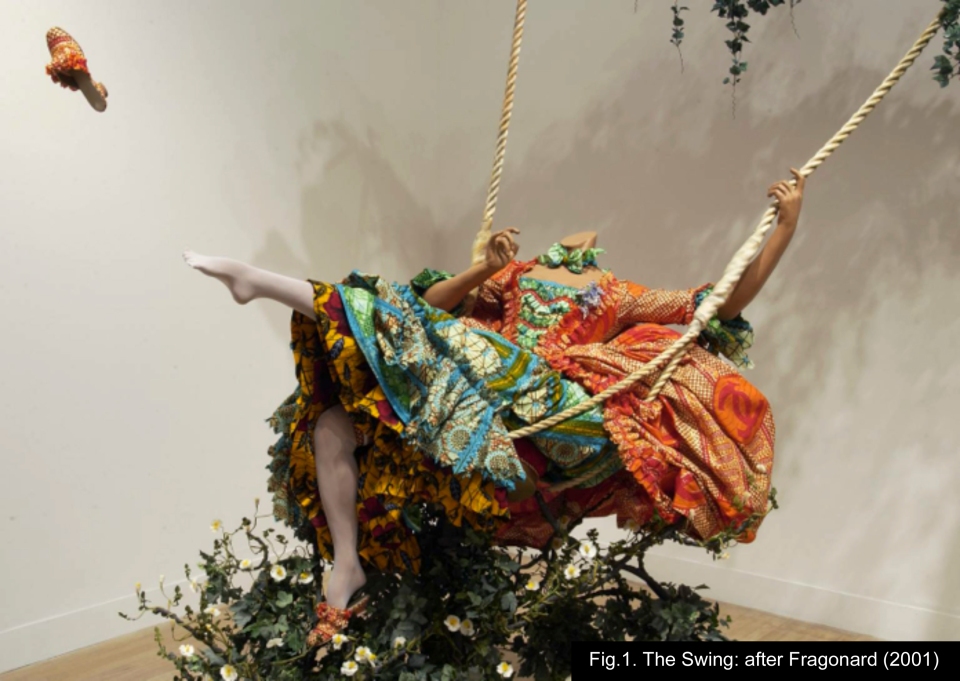The Idea of Race Within Art
‘The Human Genome Project shows there is no such thing as race’ (Craig Venter cited in Malik 2007) this scientific fact supports the idea that race is a social construct with no tangible reality. This document will look at how Yinka Shonibare attempts to break down this social construct within his artwork.
Born in London, Shonibare moved to Nigeria at the age of three. He returned to London studying at, Goldsmiths University where he received his MFA. His works almost always use brightly patterned “African” fabrics. However the fabric is not being used to display Shonibare’s heritage, but instead the idea that ‘there is no pure race’ (Renan 1990). These fabrics demonstrate a cultural hybridity due to them originally being manufactured in Manchester using Dutch wax printing techniques. After being exported to Africa they ‘became popular during the African independence movement, when their bright colours and geometric patterns became associated with the struggle for political and cultural independence’ (Taylor 2003) gaining them the label “African”. As a result of this hybrid fabric being adopted as an African stereotype their culture has been interwoven with a small part of both English and Dutch culture.
Levinas (1979) theorises that we confirm our own identity by realising our differences with the ‘Other’. In this case the conservative European stereotype is enforced because we are not the vibrant African ‘Other’. However this is an area Shonibare again attempts to disrupt. He does this by placing the fabrics within traditionally European scenes. The Swing: after Fragonard (Fig.1.) is an example of where he has done this. The idea of ethnic hybridity within this work is furthered by the contrast of the mannequin’s dark skin and white tights.

Although challenging, Shonibare’s works are ultimately accessible, often humorous. Much like Fragonard’s original painting The Swing 1767, that encapsulated ‘for many the finesse, humour and joie de vivre of the Rococo’ (Duffy, 2011). The original painting contained 2 figures, one pushing the girl on the swing and the other hidden in the foliage looking up her skirt. Removing these figures in the sculptural work causes the viewer to embody them, free to move around and even recreate the mischievous feeling of looking up her skirt.
The work has no head ‘which may allude to the literal fate that awaited the aristocracy after the French Revolution; only twenty-five years after Fragonard painted The Swing’ (Taylor 2003). However it could also be a way of removing empathy. ‘humans have an amazing ability to empathize with other humans’ (Winge 2014), by removing the head the figure is dehumanised. Silverstein (2013) explains that racism itself is a lack of empathy, caused by the inability to project personal emotion on to the unfamiliar “Other”. By removing the head, and with it empathy Shonibare creates a feeling much alike to that of racism towards his work.
To conclude, the scientific truth is that ‘There Is No Such Thing as Race’ (Sussman, 2014) and by blurring the origins of tradition through cultural hybridity Shonibare supports this idea. However, he also toys with the viewer’s unconscious creating feelings that deep down we know are wrong, mirroring the ides of racism.
References
Duffy, Stephen et al. (2011) The Wallace Collection, London: Scala Publishers Ltd.
malik, k. (2007) why do we still believe in race? Online: http://www.kenanmalik.com/essays/catalyst_racial_science.html (accessed 19/3/15)
Levinas, E. (1979) Totality and Infinity: An Essay on Exteriority Berlin: Springer Science & Business Media (accessed 19/3/15)
Renan, E. (1990) “What is a Nation?.” Nation and narration Online: http://ig.cs.tu-berlin.de/oldstatic/w2001/eu1/dokumente/Basistexte/Renan1882EN-Nation.pdf (accessed 19/3/15)
Silverstein, J. (2013) I Don’t you’re your pain Online: http://www.slate.com/articles/health_and_science/science/2013/06/racial_empathy_gap_people_don_t_perceive_pain_in_other_races.html (accessed 19/3/15)
Sussman, R. (2014) There Is No Such Thing as Race Online: http://www.newsweek.com/there-no-such-thing-race-283123 (accessed 20/3/15)
Taylor, R. (2003) The Swing (after Fragonard) online: http://www.tate.org.uk/art/artworks/shonibare-the-swing-after-fragonard-t07952/text-summary (accessed 19/3/15)
Winge, J. (2014) Rule of empathy Online: http://tvtropes.org/pmwiki/pmwiki.php/Main/RuleOfEmpathy (accessed 19/3/15)
Renan, E. (1990) “What is a Nation?.” Nation and narration Online: http://ig.cs.tu-berlin.de/oldstatic/w2001/eu1/dokumente/Basistexte/Renan1882EN-Nation.pdf (accessed 19/3/15)
Fig.1. Shonibare, Y. (2001) The Swing: after Fragonard [sculpture] Online: http://www.tate.org.uk/art/artworks/shonibare-the-swing-after-fragonard-t07952 (accessed 19/3/15)